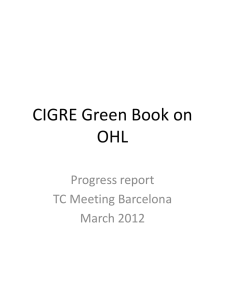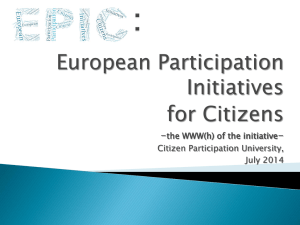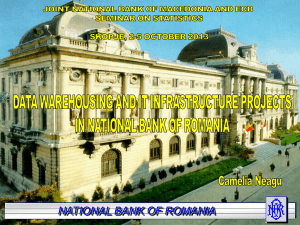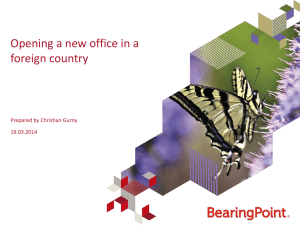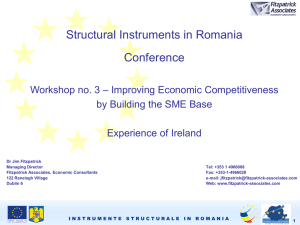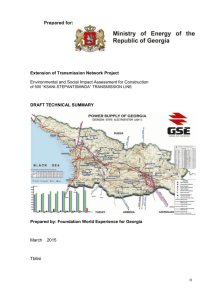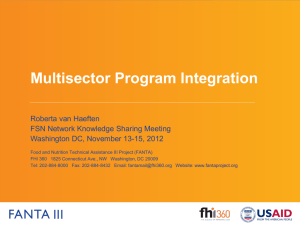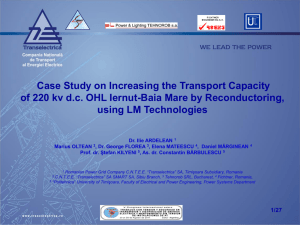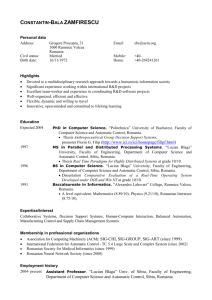cittes - Cacier
advertisement
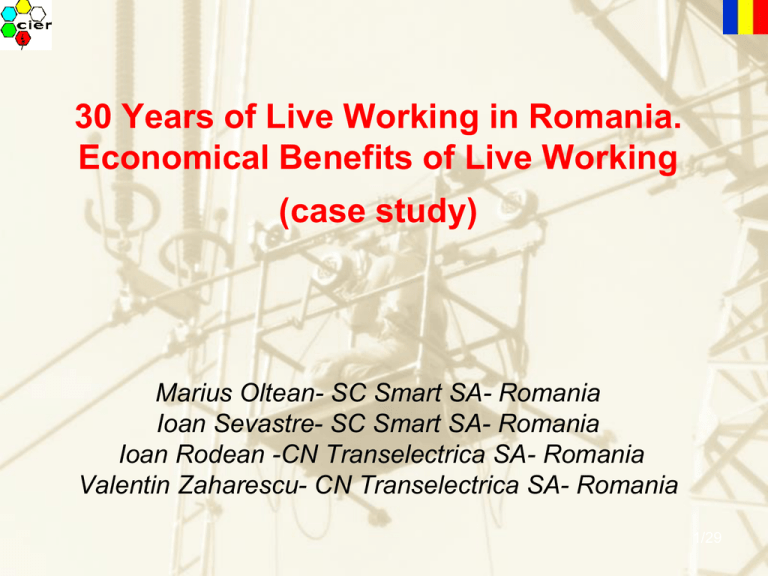
30 Years of Live Working in Romania. Economical Benefits of Live Working (case study) Marius Oltean- SC Smart SA- Romania Ioan Sevastre- SC Smart SA- Romania Ioan Rodean -CN Transelectrica SA- Romania Valentin Zaharescu- CN Transelectrica SA- Romania 1/29 Content 1. Introduction. A Brief Overview of LW History 2. The Beginning 3. Further Activity 4. The Present Time 5. LW Persectives in România 6. Technical and Economical Benefits of LW (case study) 2/29 CITTES 2011 Some history…. The first country in the world that tried to work live was USA -1913. Canada -1929. Former USSR -1940. Sweden -1949. France- 1958 GDR- 1969 3/29 CITTES 2011 The Begining In 1975 the interest for a new technology was revealed in Romania. As consequence in 1978 a contract between Romania and DDR, for LW implementation was signed. 4/9 CITTES 2011 1979 -the training of a work team from IRE Sibiu in the German Democratic Republic at Berlin-Neuenhagen . The second training took place in Sibiu between 18-28.09.1979, under the surveillance of german instructors. 5/29 CITTES 2011 The first five 400kV technologies: • The replacement of suspension strings; • The working at the phase conductors; • The preparation for dyeing of the supporting pilons; • The painting of the metallic supporting pilons • The removing of the unwanted objects from the pilons. 6/9 CITTES 2011 7/9 CITTES 2011 the first live work performed in Romania, 25.09.1979, on the pilon 198 of 400kV Sibiu –Tantareni OHL. suspension insulator replacement and technical revision of the conductors, using an insulated lather and a mobile charriot. 8/9 CITTES 2011 9/9 CITTES 2011 1979 the first technical regulation for Live Working on 110400kV, PE141/79, 10/9 CITTES 2011 Further Activity • 1982 – 1985: the training courses for five teams at Sibiu. • 1983: manufacturing of 5 Live Working suites. • 1987: manufacturing of the tool set for live maintenance of 750KV overhead lines • 1982- 1994: 58 live maintenance technologies for 110-400kV overhead lines were elaborated and tested. • 1996: manufacturing of the first tool-set for MV Live maintenance 11/9 CITTES 2011 2001: together with the outsourcing of the maintenance activities of TRANSELECTRICA National Company, live maintenance = SMART S.A . 12/29 CITTES 2011 2002: the Live Working National Committee 23.07.2003: Romanian National Live Working Association (A-LST-R). www.lst.ro Every three years- an International Live Maintenance Symposium. 13/29 CITTES 2011 The specialists from Romania at the international LW Conferences ESMO, CITTES and ICOLIM (especialy) -theoretical papers and practical demonstrations 14/29 CITTES 2011 The Present Time • 80 Live Maintenance technologies. Smart crews are able to perform LW maintenance on OHL and in substations, from 20 to 400kV • there are also some erecting, designing and consultance companies which are interested in LW. 15/9 CITTES 2011 LW Persectives in România • The CN Transelectrica SA intends to elaborate a lasting program of organization and development of hot-line work. One of the targets: the establishing of a National LW Training Center. • S.C. SMART S.A. intends to to extend this activity. • Interest for LW implementation especially for Medium Voltage coming from the distribution companies. 16/29 CITTES 2011 Technical and Economical Benefits of LW (case study) Is really Live Working necessary? Is really Live Working efficient? Is really the implementation of Live Working technically and economically justified? 17/29 CITTES 2011 LOSSES AND CONGESTION IN TRANSMISSION POWER GRID • Gaps and voltage-breaks are a source of economic loss (damages) in industry, commerce, agriculture, transport or are creating inconvenience in supplying residential customers. • The interruption of power supply is accompanied by damages, lack of production, reduced quality of products, reduced productivity in manufacturing scrap, defects in equipments, technological process disturbances (superior in time to the power interruption), accidents, additional costs for salaries, materials, energy, etc. 18/29 CITTES 2011 • For refineries, paper mills or production of electronic components, even a few seconds break can lead to processes stopping and therefore economics losses. • For stationary situations in NPG, Transelectrica SA performed all sorts of studies. As a result series of practical measures were taken, one of them and perhaps the most important is the extension of Live Maintenance. 19/29 CITTES 2011 Four types of characteristics: - the A model. The consumers case on which the effects of voltage loss occur after duration of critical outage (tA), which are evidenced by a certain amount of damage (dA), the further losses are negligible; - the B model. The case of companies on which the amount of businesses damage is proportional only with outage time and occur after a certain time (tB) (cement factories, businesses engineering); - the C model. This is a combination of the first two models. The effects of disconecting occurr only after a longer period, but have a important value beyond the critical time (tC). Further damage is proportional to the disconnecting duration (in the aluminum industry, technological processes in steel etc.). - the D model. With different critical period’s t1, t2, t3, for various plants, conected technological processes and which lead then to various damage proportional to time (chemical plants, petrochemicals, some spinners). 20/29 CITTES 2011 LIVE WORKING APPLICATION IN TRANSMISSION POWER GRID Conventionally, in the event of deenergising of an 400 kV OHL, with taking over of the consumers in this area through other OHLs of TPG, results in energy loss, on detour lines, of about 5 MW / h active power. In a specific case of interruption of a OHL 400 kV, for only 10 days, 8 hours/day, may be produced daily active energy loss in the order of 120 MW/h and of 1200 MW/h, for 10 days total. With the 10 days interruption duration for technical revisions for 20 400 kV OHLs, during a calendar year, the energy losses reach 24,000 MW / h and their cost would be around 720,000 Euros. 21/29 CITTES 2011 User type Failures Programmed Withdraws [€/kWh] [€/kW] [€/kWh] [€/kW] Industrial 8,7 2,6 3,8 0,8 Service 11 1,9 7,2 0,8 Agriculture 4,9 0,54 1,6 0,18 Residential 0,61 0,068 0,3 0,034 Public 3,4 0,65 1,5 0,23 User type Failures [€/kWh] Programmed Withdraws [€/kWh] Industrial 8,05 5,61 Commercial and Service 12,07 8,2 Agriculture 1,83 1,22 Residential 0,98 0,85 Public 1,59 1,22 Food Industry 1,59 1,34 22/29 CITTES 2011 • A first example: live replacement of bus-bar insulation in 400/110/6kV Braşov substation. Wednesday OHL 400kV Length [km] Sunday swP swQ swPQ [MWh] [MWh] [MWh] swP [MWh] swQ [MWh] swPQ [MWh] Sibiu 125,3 132,1917 0,0386 132,2303 41,3656 3,1068 44,4724 Bradu 150,7 443,5 6,7417 450,2414 371,8928 19,2345 391,1273 Gutinaş 124,483 174,38 22,79 197,159 94,086 12,8911 106,9771 Dârste 13,2 5,615 0,225 5,84 4,4225 0,4627 4,8852 23/29 CITTES 2011 COMPARATIVE ANALYSIS FOR INSULATION REPLACEMENT IN 400 KV BRAŞOV SUBSTATION 24/29 CITTES 2011 • Suplimentary considerations on the advantages of Live Working Insulation replacement on a 220 kV tension tower. It is assumed that the 220 kV OHL active power is 150 MW. Deenergised OHL Energised OHL Number of workers 6 6 Number of working hours 4 7 Number of operators 2 1 Number of working hours 2 3 Labor costs (Euros) 572.04 970.17 Vehicle costs (Euros) 30.65 46.88 Tools redemption (Euros) 7.21 15.19 Energy shortfall (MWh) 600 0 50,409.90 1,032.24 Total (Euros) 25/29 CITTES 2011 COMPARISON BETWEEN LW AND CLASSIC WORK 26/29 CITTES 2011 Conclusions • With a 30 tradition the Live Maintenance in Romania is an ongoing activity. There is an interest fot this kind of work from transmission company. The distribution companies in Romania are still searching for the real benefits of LW. • The presented studies demonstrates, against general current which considers that LIVE WORKING is performed with higher costs than the work on deenergised line that Live Working has an important economic advantage. • Regarding the congestions Live Working is not only a recommendable technology, it is mandatory in congestion management. 27/29 CITTES 2011 THANK YOU FOR YOUR ATTENTION!!! 28/29 CITTES 2011


